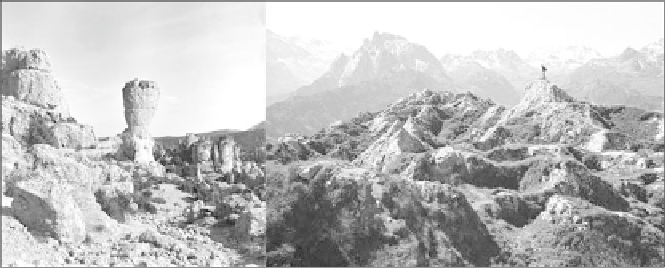Geoscience Reference
In-Depth Information
Fig. 7.5
(a) Characteristic dolomitic relief: chaos at Mourèze, Hérault France. (b) Sinkholes
from dissolution of gypsum: Vanoise, a place called
Villard's tooth
(2284 m), France; the per-
son standing on the highest hillock gives the scale.
Photos
: author.
Gypsum
is not a carbonate but a sulphate (Table 7.1). It is much more
soluble than dolomite and calcium carbonate. Gypseous terrain exhibits
characteristic sinkholes formed after the last glaciation (Fig. 7.5b). Some
tourists even confuse them for cannonball craters! The process is called
piping
. Paradoxically in the Alps, because of tectonic activity, gypsum
outcrops correspond to high points.
When the rock is pure, hard and massive, attack takes place mostly by
chemical dissolution. The soil is restricted to the uneroded part of the
small decarbonatation residue. It is therefore thin. On the other hand,
when the rock is soft (marl, chalk) there is disintegration and mixing of
decarbonatation residues and individualized calcareous fragments.
Decarbonatation residue
Two limiting cases have to be considered in humid mountains
(Duchaufour and Bartoli 1966; Legros
et al
. 1987). On a slab
in situ
, the
contact between soil and substratum is reduced to a plane; the slab is
stable; calcium carbonate is situated upslope in relation to the direction
of percolation of water. Acidification is rapid, the calcifuge alpenrose
(
Rhododendron ferrugineum
) can establish (Fig. 7.6 case 1). Contrarily,
in the scree, the boundary between the divided rock and pedological
residue is broader (Fig. 7.6 cases 2 and 3).
Degree of fragmentation of the rock

